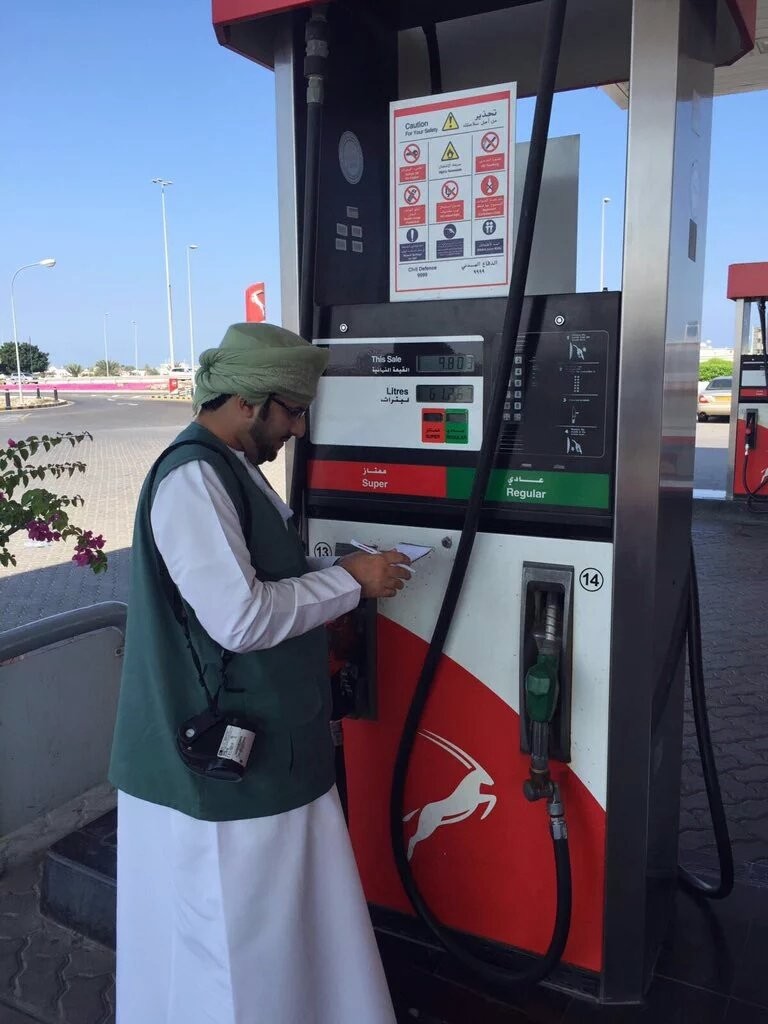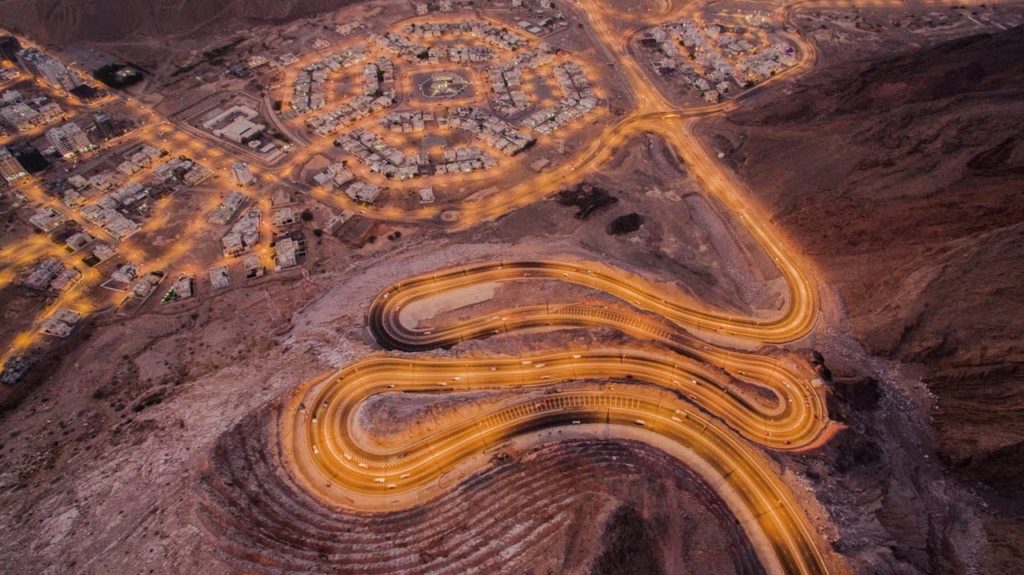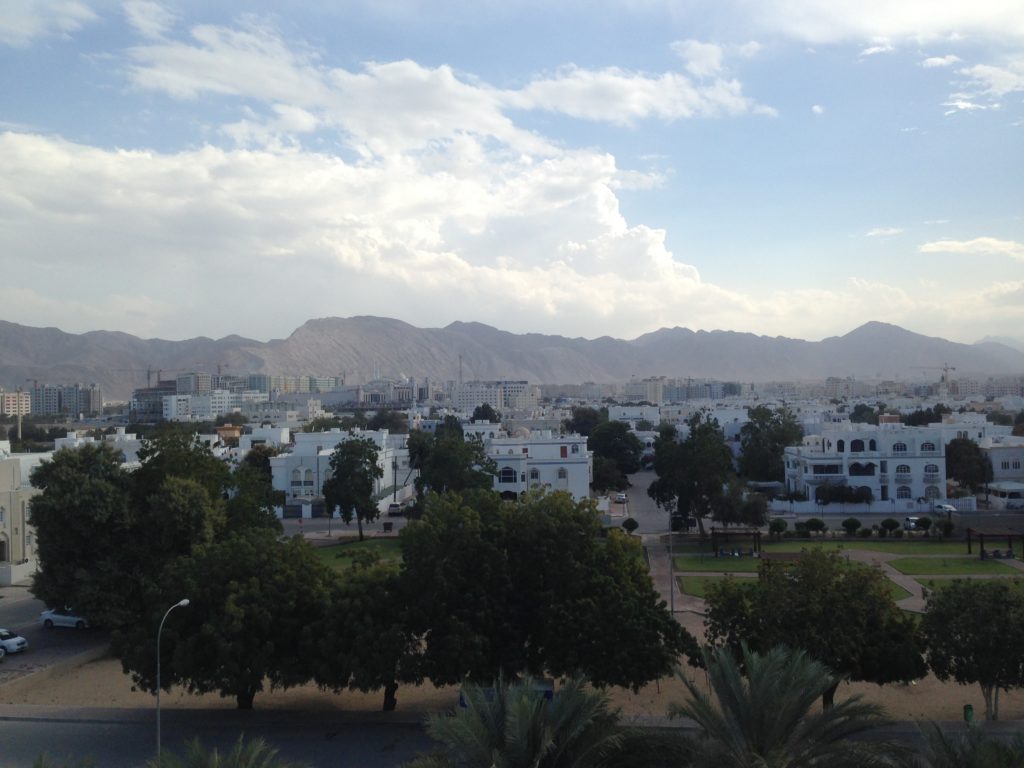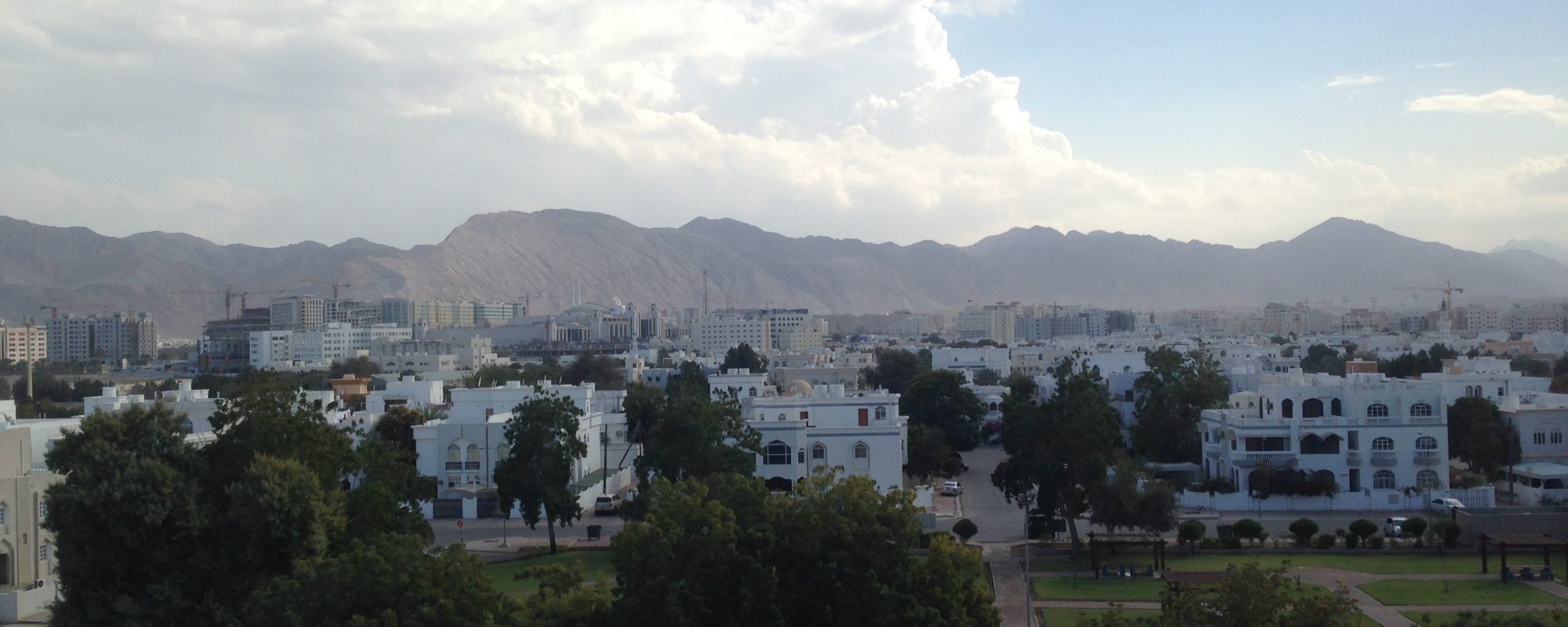Forecasting the weather is difficult in Oman. While it’s warm and sunny almost every day, problems arise when it does rain, so people tend to keep one eye on the sky. Muscat averages just a couple inches of rain per year that come in brief downpours of a few minutes. When these outbursts happen, an unwelcome but familiar series of events unfold: roads and buildings flood, property is damaged, and people lose their lives attempting to navigate the floodwater. Certain low-lying neighborhoods are worse-off than others, but in the days after a rain, one can expect to see major detours to avoid swaths of murky water, and closed businesses assessing the damage. Like most buildings in Oman, our apartment isn’t weatherproof, and water streams in through our third floor windows when it rains, so we’ve gotten in the habit of pulling our rugs up from the floor at any sign of clouds, lest they bleed (a lesson we learned the hard way after the first rain).
The most reliable source for storm warnings is the Directorate General of Meteorology of the Public Authority for Civil Aviation (PACA), which I follow on Twitter. I’ve noticed a pattern among their tweets, which are the same every day (much like the weather here). Every morning, PACA shares a satellite image of the eastern Arabian Peninsula, with a nearly identical description each time – something to the effect of “The presence of low clouds over parts of the northern and eastern coastal regions.”
Low clouds, of course, mean the possibility of precipitation, but the Directorate General rarely says there will be rain. When they do predict it, they tweet a scan of a stamped letter warning of the possibility, appending wa Allahu ‘alim to the end of the message, meaning roughly “but Allah knows all.” Sometimes the rain comes without warning, and other times it doesn’t come when predicted. Allahu‘alim.
Recently, clouds of a different variety have been gathering over Oman, ones that forecasters have been predicting for years. In the first issue of this year’s Oman Economic Review, an article titled “The Coming Storm” references the continued global slump in oil prices and looks to local business leaders for predictions on how Oman will fare. 2016 is being widely acknowledged as a year of financial reckoning here, and it seems that all eyes are beginning to scan the horizon for signs of change.
Hundreds of workers in Oman’s oil sector were laid off last fall, which prompted unprecedented labor organization – a planned strike was averted only when the government promised to investigate the firings. Then, at the end of December, representatives from Ministry of Finance and Ministry of Oil and Gas announced that consumer petrol prices would increase for the first time in over a decade. Chatter about reducing the state subsidy on gas crept into Oman after the United Arab Emirates and other Gulf countries hiked their prices in 2015 to counter unbalanced budgets from the (still) plummeting price of oil. The price hike in Oman was foreshadowed last year by curiously prescient op-eds in the state papers, with headlines like “Will Oman go United Arab Emirates way on fuel subsidies?”[1], calling for Oman to follow the U.A.E.’s lead.
That article quoted ‘independent experts’ who said that diesel prices might actually fall below the regulated prices, which would lower production costs for companies in Oman, which might drive costs down for consumers. “This way, everybody is a winner,” one of the experts said.
“Oman to fall from 9th cheapest fuel in world to 13th”[2] another headline read, framing the change in a bigger-picture, positive light. On January 15th, the cost of super unleaded fuel increased from about $1.17 USD per gallon to $1.59. Likewise, the cost of regular increased by around $0.23 per gallon, and diesel by $0.13. With these increases, a favorite factoid of Omanis that “gas is cheaper than drinking water” is unfortunately no longer true.
The day the new prices were implemented came and went without much issue. Throughout the month, a public awareness campaign sought to control and assuage consumer fears about the new prices. In the days before the change, the police warned of the dangers of hoarding gas in unapproved tanks. After the change, hosts of the Omani equivalent of NPR’s “Car Talk” took calls and talked at length about the octane difference between super and regular, and the effects it could have on your car’s engine if you downgrade (for most drivers, none). Pump attendants have started asking if drivers want super or regular, whereas high-octane super had once been the default. One morning-mix radio host talked about the merits of bicycling and walking, and the advantages of cars with good fuel economy – things not often discussed in a country where nearly everyone drives a four-wheel-drive S.U.V.

On January 14th, the day before the gas prices changed, when lines at the petrol stations were just slightly longer than usual, another big change was announced. The government of Oman took out a $1 billion USD syndicated loan from eleven banks to cover the deficit it posted in 2015, after years of multi-million dollar surpluses. With the current price of oil at nearly a third of what the government needs to balance its budget, a loan was inevitable to cover the shortage.
Then, on January 20th buzz about property, excise, and value-added taxes began to circulate, quoting a source in the parliament-like Majlis al Shura along with more ‘independent experts.’ “Implementation of VAT is in the final stages… So, by the mid-2017, we can expect VAT being introduced in Oman,” the source from the Majlis said[3]. The article carried an infographic of VAT rates across the world, making the proposed 3-5% seem small in contrast to European figures in the 20% range.
Taken in isolation, these events might seem like frenzied last-ditch measures, but they have been a long time coming. Western observers have been sounding the clarion call of an inevitable economic and political crisis in Oman for decades. With a proven oil reserve of 5 billion barrels the Omani fields are but a small fraction of their neighbors’ –the UAE’s is 97 billion, Saudi Arabia’s is a whopping 266 billion – and many see the Sultanate’s dwindling stores as a recipe for instability. The end of oil in Oman has provided plenty of fodder for journalists and scholars, who almost sound eager to see what financial (and political) ruin would look like in a heretofore-wealthy Gulf state.[4]
Some of the wealthier GCC countries have begun to discuss reforms that belie the foundations of the rentier state. This winter, Saudi Arabia unveiled a new budget that reduced education subsidies; Saudi, Bahrain, the U.A.E. and Qatar all increased fuel prices; and the implementation of a VAT for all countries is being talked of as an inevitability. Emirati commentator Sultan Al Qassemi has argued that taxation, reduction of subsidies, and the decline in government jobs might necessitate a rethinking of the social contract that keeps the rentier model in the Gulf intact. The Gulf social contract, as he explains, is the notion that citizens of GCC states “delegate the running of the state to the ruling families so long as governments refrain from taxing them.”
Plans for increasing government revenue through reducing subsidies and implementing taxes in Oman have been in the works for at least the last quarter century. In 1991, in the wake of the oil crisis following the First Gulf War, the Omani government asked the World Bank to provide “a frank assessment of the Government’s economic policies.” Ask and you shall receive – the report warned if Oman’s expenditure and oil production continued unchecked, wells would run dry and their spending-reliant financial ecosystem of civil employment, expensive imports and fixed currency rates would collapse. Ominously, it predicted “major economic and social upheaval” if this happened, as citizens of Oman would be “forced to give up accustomed standards of consumption.”[5]
The report provided many ways to prevent this from happening, but emphasized a few critical points: reducing excess public expenditure, increasing return-based foreign and domestic investment, developing the native workforce, encouraging private enterprise, and attracting foreign capital. Collectively, these measures together were to be the antidote to inevitable financial and social ruin. The World Bank also suggested that more oil wouldn’t solve the problem, noting that “Oman’s previous additional discoveries of oil led to higher, and ultimately unsustainable, levels of defense, national security, and civilian public expenditure.”[6]
The sobering assessment eventually became the playbook for Vision 2020, a cleverly named initiative of the Omani government that seeks to wean Oman’s economy off of oil and excessive government spending by the year 2020.[7] The World Trade Organization summed up the initiative in three words: “Liberalization, Diversification, and Privatization,” concepts that are still striven for but remain largely unrealized in the Omani economy.
Some aspects of the World Bank report were defiantly ignored. In the year the report was published, the Sultanate was producing 750,000 barrels of oil per day – at that rate, the World Bank said Oman would run out in 18 years, in 2011. Despite this, the government gradually increased its daily production output, which reached 1 million barrels per day in 2015.[8] Mathematically, with reserves at 5 billion barrels, and a production rate of at least 750,000 barrels per day for 18 years, Oman’s fields should have dried up well before 2011. Production dipped only slightly in the mid-2000’s, but never below about 700,000 barrels per day. So how does production continue?
The official reserves figure of 5 billion barrels reflects the proven, extractable oil through conventional recovery methods. Importantly, the “oil in place” in Oman, or total oil in the ground is estimated to be 48 billion barrels – nearly ten times the reserve figure.[9] Oman has been at the vanguard of enhanced oil recovery technology (EOR), which has allowed them to extract an ever-increasing stream of oil from their sleeve like a magician’s handkerchief. While EOR is both cost- and energy-intensive, Muscat have has been able to delay the inevitable “end of oil” for at least another twenty years, if not longer, at the current production rate.
Since the government was able to maintain its desired oil revenues, it continued to spend lavishly on infrastructure, civil-sector growth and defense[10] as predicted. Even so, nearly all of the other “antidotes” from the World Bank report quietly worked their way into Omani economic policy. The report (and subsequent Vision 2020 initiative) sparked smart investments in high-return projects like brand new, high volume airports in Muscat and Salalah, the deep-water port and economic free zone in Duqm, and what is set to be the world’s largest solar field in the Omani interior.[11]

Work force development and encouragement of private enterprise have been the most visible aspects of Vision 2020. Countrywide access to education and training opportunities have increased, and the policy of Omanization, or laws that require a percentage of Omani employees at all businesses, have created a sizable Omani workforce. The government even created a General Authority for the Development of Small and Medium Enterprises (SMEs), and weekly fairs, conferences, and roundtables all look to SMEs as the future of the Omani economy. That said, countless polls conducted every few months routinely show that Omanis would still prefer to work for the government, even after His Majesty himself lauded the merits of the private sector.
Finally, Oman has managed to lure in foreign investors from across the world including China, Europe, and most notably, Iran. Two high-profile Iranian projects were unveiled this month: a joint gas project that would send a third of Iran’s gas to Oman via pipeline for refinement and sale, and the construction of a Khodro Iran auto manufacturing plant in Duqm, setting up Oman as a manufacturer and regional distributor of Iran’s “national car” for African and West Asian markets. Furthermore, in consultation with the World Bank (again), Oman is in the process of loosening its foreign investor laws this year – formerly, an Omani national had to have a 35% stake in any business incorporated in the Sultanate. The latest plan would allow foreign companies to retain a 100% stake in business in Oman, eliminating one of the largest inhibitors to outside investment.
The 1993 World Bank report eventually called the outlook for Oman “anything but bleak,” which speaks to the great deal of potential in the Sultanate, despite its challenges. Journalists and observers outside of Oman are wont to remind readers of Oman’s perceived ‘powder-keg’ conditions – economic distress, bad neighbors, a diverse society, and aging leadership. But citizens didn’t take to the streets when the January measures were introduced, and National Day celebrations this past November were more fervent than ever, even in the face of the looming storm. Omanis understand that times are changing in Oman, and that incremental steps will be taken to prevent a crisis. Many believe that Oman will come out on top.
It seems Omanis and their government share the same spirit of defiant, relentless optimism, even looking ahead to what will surely be the Sultanate’s bleakest economic year in modern history. Moreover, for the time being, the social contract between Omani citizens and the Sultan remains strong. The same mentality that engenders national pride among Omanis and pushes Omani companies to help develop innovative technologies to stretch their oil might be enough to carry them through the storm.

For now, layoffs, the increased price of gasoline, and the introduction of taxation are just low clouds to be watched. On February 17th, Standard & Poor’s downgraded Oman’s credit rating two levels to BBB-, and rains and flooding swept Muscat the same day with short warning. A further downpour of economic (and social) unrest is certainly plausible, but forecasting of any kind is an imprecise science, and best avoided at this point. In the meantime, all Omanis can do is hope that even darker clouds don’t roll in. Wa Allahu ‘alim.
[1] http://timesofoman.com/article/64469/Oman/Oman-will-probably-follow-the-United-Arab-Emirates-(UAE)-to-end-subsidies-on-domestic-petrol-believe–experts
[2] http://timesofoman.com/article/75319/Oman/Transport/Price-of-fuel-prices-set-to-rise-in-Oman-from-January-15
[3] http://timesofoman.com/article/75888/Oman/Government/Oman-plans-Value-Added-Tax-by-the-middle-of-next-year-says-a-member-of-the-Majlis-Al-Shura
[4] See “The next Middle East crisis will start when this man dies” from the American Enterprise Institute and “Simmering Unrest and Succession Challenges in Oman” from the Carnegie Endowment for International Peace.
[5] “Sultanate of Oman: Sustainable Growth and Economic Diversification,” May 31, 1994: The World Bank, p. 32. A full PDF of the report is available here.
[6] “Sustainable Growth,” p. 121.
[7] Jeremy Jones & Nicholas Ridout, A History of Modern Oman (Cambridge: Cambridge University Press), p. 223.
[8] http://www.eia.gov/beta/international/analysis_includes/countries_long/Oman/oman.pdf
[9] http://www.ogj.com/articles/print/volume-96/issue-14/in-this-issue/drilling/oman-prepares-for-oil-expansion-and-gas-production-for-lng-export.html
[10] Oman has jockeyed with Saudi Arabia, Iraq and fledgling South Sudan for the top defense spender as a percentage of GDP for the past decade. According to the World Bank, it’s back to number one in the most recent data year (2014), with 11.8% of GDP.
[11] The solar field is being build to power steam-based EOR, not for grid-based electricity.

